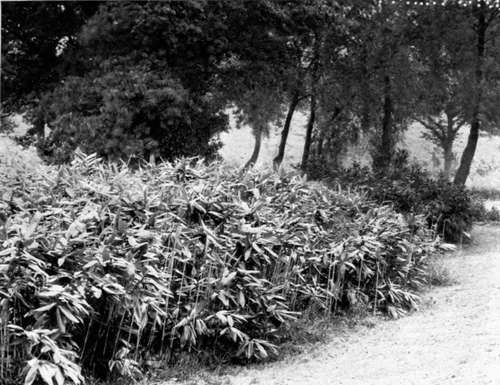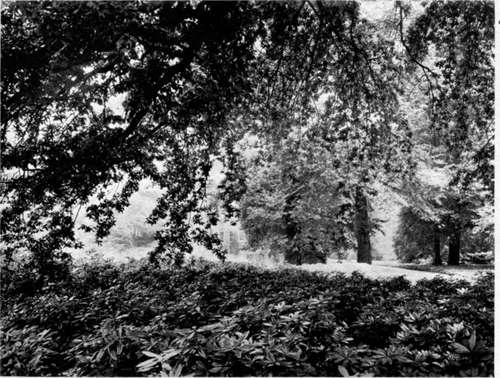The Foliage Effect
Description
This section is from the book "What England Can Teach Us About Gardening", by Wilhelm Miller. Also available from Amazon: What England Can Teach Us About Gardening.
The Foliage Effect
Of all the broad-leaved evergreens that are cultivated for foliage alone, box is undoubtedly the most important for Northern countries. True, holly has a deeper religious significance, and when it is grown by the mile for hedges little or no fruit is expected.

A hardy evergreen bamboo, taller than a man, at gravetye, the home of william robinson, who originated the * 'wild garden" idea. our equivalent for this is a run din aria japonica. See pages 174, 328.

The wrong way to arrange rhododendrons, i. e., jamming them in flat, solid masses. wild garden effects are preferable. the " peat garden" is also a better idea. See page 167.
But holly is identified with the pleasure grounds, while box is the most characteristic plant of the garden proper. Indeed, the only plant which lives for a century or more in old gardens is box. That is why the sight and smell of box stir old family memories more than any other plant in cultivation. I do not see how any garden can have charm without it. In formal gardens, at least, we should always use some dwarf box for edging flower beds, and in every garden there should be some tree box to symbolize the beauty of a green old age, and also to serve as a connecting link between the generations.
The losses which Americans suffer from box are often very heavy and peculiarly distressing. I confess that I have occasionally joined in the cry for a hardy equivalent of box. The popular substitute for box is Ilex crenata, of which there are three forms of varying merit. One of them is said to be even glossier than box in winter, as well as hardier and possibly of quicker growth. This "Japanese box" mimics the box leaf fairly well, and perhaps it will exhibit in age that "embossed" effect which, as Henry Hicks observes, is a crowning beauty in old boxwood. But I am sure it lacks the pungent odour of box, which is so potent in restoring precious memories. However, some people dislike the odour of box.
The solution of the difficulty may be Buxus Japonica, which is hardy at the Arnold Arboretum. Dallimore says it is lighter green than other boxes, has rounder leaves and rather loose habit. The Arboretum specimen, however, is dense and dark enough, except that after a long drought it becomes pallid.
How to prevent losses with box is a long story. Every one who wishes to dwell with the best that the past has to give us, and to profit by the experience of Americans who have spent thousands of dollars in moving century-old box to new gardens, should read the articles on box that are referred to at the end of this chapter.
Ivy is, of course, the most precious climber or creeper grown solely for foliage effect. It is common enough to see trained pyramids of it in formal gardens, but I believe we shall never achieve "garden magic" in that way, or by growing bay trees in tubs. The bay tree is the laurel of the ancient poets (Laurus nobilis) yet the sight of it does not thrill our hearts. Only free, luxuriant growth, I believe, has sufficient power of suggestion.
Unexpected aid may come from the "hardy evergreen bamboo," for we should not think of all bamboos as "tropical." Bamboos are merely tall grasses, and they fit our woods to perfection. Of the seven kinds that are hardy in the North, most belong to the slender type of beauty, but there is one which has as much body as a rhododendron. It may not be evergreen north of Philadelphia, where I once saw a superb specimen that was eight feet high. Nurserymen call it Bambusa Metake, but its correct name is Arundinaria Japonica. As both names are formidable, I once proposed that we call it the "broad-leaved bamboo," for the leaf attains two by twelve inches. "Hardy evergreen bamboo" is, however, quite as designative, and reveals its greatest value.
The effect of this evergreen bamboo is somewhat like that pictured on plate 67 and on plate 107. To realize the glory of such a mass, you must know that it is considerably taller than a man. Then make the leaves dark and lustrous, like a rhododendron, and you will get some notion of the luxurious abandon with which everything grows at Gravetye, the home of William Robinson, prophet of wild gardening. This particular species Mr. Robinson calls Bambusa palmata, and says it is even finer than the other hardy, evergreen bamboo. The reedy effect is noticeable here. The only picture I have of Arundinaria Japonic a shows it arching gracefully to the ground.
Continue to:
Tags
garden, flowers, plants, England, effects, foliage, gardening
